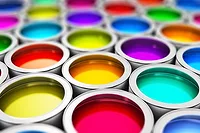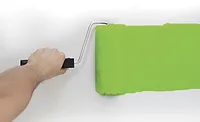Why Does the Sun Damage Paint?



Summer is great! The longer days allow the shops that we work with to accomplish even more throughout the day. In fact, we see a nearly 75% increase in daylight during the summer (comparing the summer and winter solstices). That is a lot of sun.
The downside to being a paint shop during the summer (especially some of the shops we see painting trailers or steel that is stored outdoors) is that the sun is harsh. It will affect the appearance and performance of your paint. Depending on your customer's expectations, that can be a problem. This article will discuss the sun's effects on paint, why that damage takes place and what you can do to avoid it.
Our Sun
The sun is pretty impressive. Over 99% of the mass in our solar system is the sun (it has about 330,000 times the mass of the earth). It is the source of an enormous amount of energy, a portion of which provides the earth with the light and heat necessary to support life. Without it we would be in trouble.
The energy radiated by the sun is produced during the conversion of hydrogen atoms to helium. The sun is at least 90% hydrogen by number of atoms, so the fuel is readily available. The sun's core fuses about 600 million tons of hydrogen into helium every second, converting 4 million tons of matter into energy every second as a result.
In addition to warmth, the sun supplies light radiation (visible light and ultraviolet light), and a wide range of energy types (e.g., X-rays, gamma rays and cosmic rays).
As great and necessary as the sun is, we already know that it can cause problems. Sunburn, skin cancer, etc. Let's look at how the sun damages paint.
Coating Degradation
The ultraviolet light that the sun emits degrades paint. This process is called photodegradation. The first phase in this process is photolysis, where the polymer (resin) absorbs ultraviolet radiation. As it does, it becomes excited and is raised to a higher energy state than normal. This excess energy must be eliminated.
The main way this elimination occurs is by breaking the primary bonded structure of the polymer, which forms highly reactive free radicals (free radicals being atoms that contain an unpaired electron). How easily this occurs depends on the strength of the bond. Polymers made of stronger bonds are more resistant to ultraviolet-induced breakdown. Lower wavelengths is where these polymers become more vulnerable.
After photolysis begins, the second phase in the photochemical degradation of polymers, autoxidation, comes from the reaction of the free radicals with oxygen, forming peroxy radicals.
Photolysis of other atoms in the coating is also possible, thus producing more free radicals. At higher energy levels, the free radicals react with oxygen or water (that aren't associated with the resin). All of these reactions make more free radicals, setting off more reactions that cause breaks in the binder molecules.
The additional reactions cause splitting and evaporation of the coating. The exact way the coating breaks down will depend on the polymer structure, the net effect is deterioration in physical, chemical and performance properties. Ultimately this will lead to corrosion of the substrate that the coating was originally supposed to protect.
Resin Consideration
This article paints a grim picture (sorry for the paint pun). We do, however, recommend that painters seriously consider the resin in their coating before applying it. The formulation of the coating can do quite a bit to mitigate the destructive effects of the sun.
Coatings that utilize aliphatic polymers do not absorb ultraviolet light but are transparent to the radiation (acrylics, urethanes, etc.) and therefore are not as affected by exposure. Consider for example, Imron 3.5 HG+. This is a urethane-based coating that we have seen maintain great gloss retention over time.
Coatings made up of aromatic polymers (aromatic having less electron density than aliphatic), such as bisphenol-A epoxies, are far more absorptive and therefore subject to ultraviolet light attack. Regarding epoxies, check out this article: Understanding Epoxy Adhesion. Though epoxies are more susceptible to the sun's light, they are well-known for having excellent adhesion capabilities.
Technically, if the coating does not absorb the radiation, it cannot be affected by it. It may, however, be sensitive to attack by free radicals derived from the other absorption and excitation of other materials in the coating (e.g., additives). Ultraviolet radiation will attack ultraviolet light-sensitive layers below transparent topcoats.
Another area for future consideration is related to pigments that are in the paint. Some pigments can actually absorb ultraviolet light and create even more destructive energy (they could reflect the sunlight and create more heat, thus splitting the coating for example).
Conclusion
Though the sun is our source of warmth and light, it can ruin your day if you are a painter. The ultraviolet light causes the molecules in your paint's resin to break apart, which causes your paint to break down and chip away. This will also cause some corrosion to occur, which could be a safety concern depending on what your substrate is. We always recommend considering your paint's resin before the application. Some resins are better at adhesion, while some are better at surviving the sun's ultraviolet light.
References
-
Hare, C.H. "The Degradation of Coatings by Ultraviolet Light and Electromagnetic Radiation." Journal of Protective Coatings & Linings, May 1992.
-
Zirin, H.; Lang, K. "Sun." Encyclopedia Britannica, February 4, 2021.
For more information, contact scowlishaw@blendsupply.com or visit www.blendsupply.com.
Looking for a reprint of this article?
From high-res PDFs to custom plaques, order your copy today!








